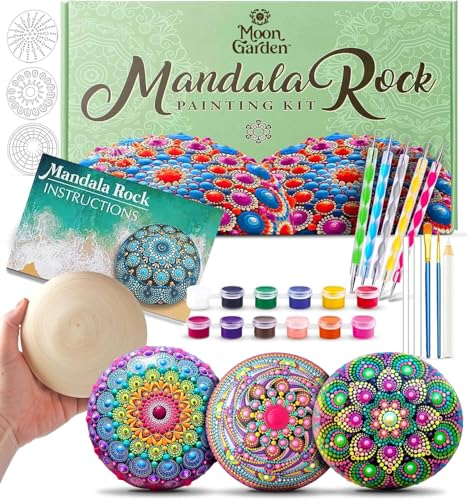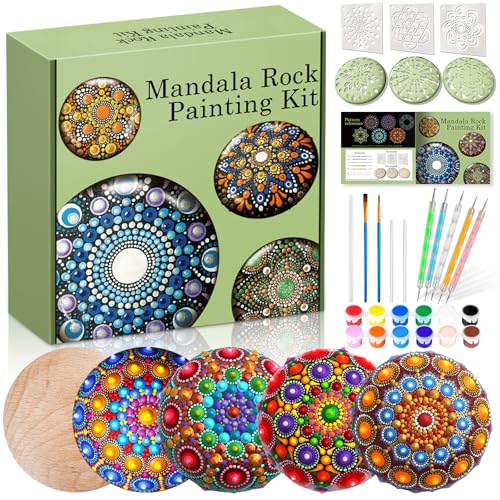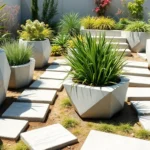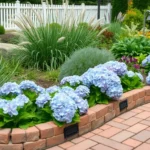We’ve all walked through gardens and admired the perfect balance of natural beauty and creative touches that make outdoor spaces truly special. Garden rock painting transforms ordinary stones into stunning decorative pieces that add personality and charm to any industry. It’s an affordable way to create unique focal points while expressing your artistic side.
Rock painting isn’t just a fun weekend project – it’s become a popular gardening trend that allows us to personalize our outdoor spaces with weather-resistant art. From simple geometric patterns to intricate botanical designs we can create pieces that complement our garden’s existing aesthetic or introduce bold pops of color.
Whether you’re looking to mark plant varieties create whimsical garden creatures or design inspiring message stones we’ll explore creative ideas that work for beginners and experienced artists alike. These painted rocks can withstand the elements while adding year-round visual interest to flower beds pathways and garden borders.
Choose the Perfect Rocks for Your Garden Art Project
Finding the right foundation stones makes all the difference between professional-looking garden art and frustrating painting experiences. We’ll guide you through selecting stones that enhance your creative vision while ensuring long-lasting results.
Selecting Smooth, Flat Surfaces for Easy Painting
Smooth surfaces provide the ideal canvas for detailed garden rock painting designs. We recommend searching for river rocks, beach stones, or weathered granite pieces that feel pleasant to touch without rough textures or deep crevices. These naturally polished stones allow paint to flow evenly and create crisp lines for intricate patterns like mandalas, flowers, or geometric designs.
Flat surfaces offer maximum painting area and stability during your creative process. Look for stones with at least one completely flat side that measures 3 inches or larger for comfortable brush work. Oval or round rocks with gentle curves work exceptionally well for animal designs like ladybugs, turtles, or fish where the natural shape enhances your artistic concept.
Avoid porous rocks like pumice or sandstone that absorb paint unevenly and create blotchy finishes. Limestone and slate provide excellent alternatives when river rocks aren’t available in your area.
Finding the Right Size Rocks for Different Design Ideas
Size selection directly impacts your design possibilities and the visual impact in your garden space. We suggest collecting rocks in three categories: small stones (2-4 inches) for accent pieces, medium rocks (4-7 inches) for focal points, and large stones (8+ inches) for statement artwork.
Small rocks excel for creating collections like painted herb markers, miniature creatures, or inspirational word stones that tuck perfectly between plants. Medium-sized stones accommodate detailed artwork such as house numbers, seasonal decorations, or pet portraits that catch attention without overwhelming garden beds.
Large rocks serve as garden centerpieces for elaborate designs like fairy houses, complex landscapes, or family handprint collections. These substantial pieces anchor garden areas and create conversation starters for visitors.
Weight considerations matter for placement flexibility, so test that you can comfortably move each rock to different garden locations as seasons change.
Preparing Your Rocks with Proper Cleaning and Priming
Cleaning removes dirt, oils, and residue that prevent paint from adhering properly to your garden rocks. We start by scrubbing each stone with warm soapy water and a stiff brush to eliminate surface contaminants, then rinse thoroughly and allow complete air drying for 24 hours.
Stubborn algae or mineral deposits require white vinegar treatment where you soak rocks for 30 minutes before scrubbing. This natural acid dissolves buildup without damaging the stone surface or creating harmful chemical residues in your garden environment.
Priming creates the perfect base coat for vibrant colors and long-lasting garden rock painting results. Apply thin, even coats of high-quality acrylic primer using foam brushes or small rollers for smooth coverage. White primer works best for bright colors, while gray primer enhances earth tones and darker palettes.
Temperature and humidity affect drying times, so prime rocks indoors or in covered areas when outdoor conditions are ideal. Allow 2-4 hours between primer and paint application for optimal adhesion.
Create Adorable Animal Designs on Garden Rocks

We’ll transform our garden rocks into charming animal characters that bring personality and whimsy to outdoor spaces. Animal designs remain among the most popular choices for rock painting because they’re instantly recognizable and appeal to all ages.
Painting Cute Ladybugs and Beetles
Ladybugs offer the perfect starting point for beginners since their simple shape requires minimal artistic skill. We start by painting the entire rock with bright red acrylic paint, allowing it to dry completely before adding details. Black paint creates the distinctive head section and center line that divides the wings, while white dots scattered across the red surface complete the classic ladybug appearance.
Beetles provide more variety in color combinations and allow for creative interpretation. Green, blue, or metallic copper paints work beautifully for beetle bodies, and we can add texture by dry brushing lighter shades over the base color. Small black antennae painted with fine brushes or drawn with Sharpie markers add the finishing touches that bring these insects to life.
Designing Colorful Butterflies and Dragonflies
Butterflies showcase our artistic skills through vibrant color combinations and intricate wing patterns. We paint symmetrical wings using multiple colors like purple, orange, yellow, and blue, creating gradients that blend naturally together. Wing details such as spots, stripes, or swirl patterns add visual interest and make each butterfly unique.
Dragonflies require elongated rocks that naturally suggest their body shape. Iridescent blues and greens capture the magical quality of real dragonflies, and we can achieve this effect by layering metallic paints or using specialty iridescent acrylics. Four delicate wings painted in translucent white or pale blue extend from the body, while large compound eyes at the head complete the realistic appearance.
Crafting Realistic Bird and Fish Rock Art
Birds demand attention to natural color patterns and proportions for believable results. We study reference photos of common garden birds like robins, cardinals, or blue jays to understand their distinctive markings and coloring. Earth tones such as browns, grays, and muted reds work well for most bird species, while bright accents highlight beaks, eyes, and wing details.
Fish designs work exceptionally well on oval or teardrop shaped rocks that naturally suggest swimming motion. Blues, silvers, and greens create realistic aquatic colors, and we add scales using a fan brush or sponge technique for texture. Swimming poses with curved bodies and flowing fins make our fish appear to glide through imaginary garden waters.
Design Beautiful Flower and Plant Motifs

Flower and plant motifs bring natural beauty to our garden rock painting projects. These designs create colorful focal points that complement our outdoor spaces throughout the seasons.
Creating Vibrant Sunflower and Daisy Patterns
Sunflowers transform ordinary rocks into cheerful garden accents. We’ll start by painting a large circle in bright yellow for the outer petals, then add individual petal details using long brushstrokes radiating from the center. The center requires dark brown or black paint to create the authentic sunflower seed pattern. Small dots and circular motions help achieve this realistic texture.
Daisies offer a classic garden flower option that’s perfect for beginners. We paint white petals around a sunny yellow center, creating approximately 8-12 evenly spaced petals per flower. Each petal should be slightly rounded at the tip and narrower at the base. Multiple daisies on a single large rock create a beautiful meadow effect.
Painting Delicate Rose and Tulip Designs
Roses require layered painting techniques to achieve their romantic appearance. We begin with a small oval center using deep red or pink paint, then build outward with curved petal shapes that overlap naturally. Each petal layer should be slightly lighter than the previous one to create depth. Green stems and thorny details complete the classic rose design.
Tulips provide elegant simplicity with their distinctive cup shape. We paint the basic tulip form using vibrant colors like purple, red, yellow, or pink in a U-shaped pattern. The petals should be wider at the top and taper toward the base. Adding darker shading along the petal edges creates dimensional effects that make our tulips appear more realistic.
Adding Tropical Palm Leaves and Succulents
Palm leaves bring exotic flair to our garden rock collection. We use various shades of green paint to create long, flowing fronds that curve naturally. Each frond consists of multiple leaflets painted as thin lines extending from a central stem. Layering different green tones adds depth and movement to these tropical designs.
Succulents offer modern botanical appeal with their geometric shapes. We paint these plants using blue-green, purple, and silver tones to capture their unique coloring. Rosette patterns work well for echeveria designs, while barrel shapes suit other succulent varieties. Small white dots can represent the waxy coating found on many succulent species, adding authentic details to our painted rocks.
Paint Inspirational Messages and Quotes

We’ve discovered that transforming rocks into messengers of hope creates some of the most meaningful garden decorations. Inspirational rock painting brings positivity directly into our outdoor spaces while offering an accessible entry point for artists of all skill levels.
Writing Motivational Garden Sayings
Motivational garden sayings work best when they’re short and encouraging phrases that celebrate nature or personal growth. We recommend starting with classics like “Bloom where you are planted” or “Plant kindness” since these resonate with gardeners and visitors alike. Creating affirmation rocks with single powerful words such as “Hope,” “Love,” or “Grow” provides gentle daily reminders for anyone walking through our garden spaces.
Popular motivational phrases include:
- “You are enough”
- “Grow through what you go through”
- “Be kind”
- “Seeds of possibility”
These painted messages serve as encouraging touchstones throughout our gardens, offering uplift during both challenging and celebratory moments. We’ve found that placing motivational rocks near seating areas or along frequently traveled paths maximizes their positive impact on daily garden experiences.
Adding Welcome Messages for Visitors
Welcome messages painted on rocks create an instant sense of warmth and hospitality at garden entrances. We suggest positioning these greeting stones near walkways, garden gates, or front entrances where they’ll be among the first things visitors notice. Classic welcome phrases like “Welcome to our Garden” or “Come as you are” establish an inviting atmosphere that makes guests feel immediately at home.
Effective welcome message examples:
- “Friends gather here”
- “Enter with a grateful heart”
- “Welcome, beautiful soul”
- “Garden blessings await”
Painting welcome rocks in colors that complement our existing garden palette helps them feel integrated rather than out of place. We recommend using weather resistant acrylic paints to ensure these greeting stones maintain their vibrant appearance through various seasons and weather conditions.
Creating Seasonal Holiday Greetings
Seasonal holiday greetings on rocks let us celebrate various occasions throughout the year while adding festive touches to our garden spaces. Spring themed rocks featuring phrases like “Spring has sprung” or “New beginnings” welcome the growing season with optimism. Halloween rocks painted with “Trick or Treat” or spooky imagery create playful autumn decorations that delight trick or treaters.
Seasonal greeting ideas by season:
| Season | Popular Phrases | Design Elements |
|---|---|---|
| Spring | “Fresh starts,” “Bloom time” | Pastel colors, flower motifs |
| Summer | “Sunshine vibes,” “Garden joy” | Bright yellows, sun designs |
| Fall | “Harvest blessings,” “Grateful hearts” | Orange, red, leaf patterns |
| Winter | “Happy Holidays,” “Peace on Earth” | Evergreen, snowflake designs |
Christmas rocks featuring “Happy Holidays” or simple tree designs bring winter cheer to otherwise dormant garden areas. We’ve discovered that creating interchangeable seasonal rock collections allows us to refresh our garden’s festive spirit throughout the year while maintaining a cohesive decorative approach.
Develop Weather-Themed Rock Art

Weather motifs bring ever-changing energy to our garden rock paintings while creating stunning visual displays that capture nature’s most dramatic moments.
Painting Sunshine and Rainbow Designs
Sunshine rocks brighten any garden corner with their cheerful radiance. We start by painting a vibrant yellow center circle using acrylic paints, then extend rays outward in varying lengths to create natural movement. Golden yellow works best for the core, while lighter yellows and oranges add depth to the radiating beams.
Rainbow designs transform ordinary stones into colorful masterpieces. We apply colors in the traditional sequence from red to violet, creating either classic bow shapes or modern geometric patterns. Gradient blending between colors produces the most realistic rainbow effect, especially when we use a damp brush to soften transitions.
Color combinations for sunshine pieces include warm oranges, bright yellows, and touches of white for highlights. Multiple sunshine rocks clustered together create a powerful focal point that draws attention throughout different seasons.
Creating Storm Clouds and Lightning Effects
Storm cloud paintings capture nature’s dramatic power on smooth rock surfaces. We begin with dark gray or black base colors, then add white and light gray highlights to create billowing cloud formations. Layering different shades produces realistic depth and movement.
Lightning effects add electric energy to storm themed rocks. Drawing zigzag lines with black markers creates bold lightning strikes, while white paint over dark backgrounds produces more subtle electrical patterns. We recommend practicing the lightning shape on paper first to achieve confident, natural looking bolts.
Atmospheric details enhance the overall storm effect. Adding small raindrops with white or silver paint creates the impression of approaching weather, while darker edges around cloud formations suggest gathering intensity.
Designing Seasonal Weather Patterns
Spring weather patterns feature fresh green elements and clear skies. We paint light blue backgrounds for crisp spring air, then add green leaves and colorful flowers to represent new growth and mild temperatures.
Summer designs emphasize warmth through color choices. Orange and yellow dominate these pieces, representing intense sunshine and heat, while deep greens suggest lush foliage thriving in warm weather conditions.
Autumn weather themes showcase the season’s dramatic color changes. Red, orange, and yellow leaves painted against clear blue skies capture the crisp, cool atmosphere of fall weather patterns.
Winter elements focus on cold weather imagery. We paint delicate snowflakes in white or light gray against blue backgrounds, creating the serene feeling of winter’s quiet beauty. White and light gray combinations work perfectly for suggesting snow covered landscapes.
| Season | Primary Colors | Weather Elements | Techniques |
|---|---|---|---|
| Spring | Light blue, green, pastels | New leaves, light rain | Soft brushstrokes, layering |
| Summer | Yellow, orange, deep green | Bright sun, lush growth | Bold colors, strong contrasts |
| Autumn | Red, orange, yellow | Falling leaves, clear skies | Gradient blending, detail work |
| Winter | White, light gray, blue | Snowflakes, frost patterns | Fine detail brushes, stippling |
Make Functional Garden Rock Markers

Painted rocks can serve as practical tools while maintaining the artistic charm we’ve been building throughout our garden. These functional markers transform ordinary stones into helpful garden management systems that combine beauty with purpose.
Labeling Herb and Vegetable Gardens
Herb markers become essential organizational tools when we paint plant names directly onto smooth rock surfaces. We can create visually appealing markers by adding simple designs or icons alongside herb names like basil, rosemary, or thyme. Painting small leaf patterns next to the text helps visitors quickly identify different plants while adding decorative elements to our garden beds.
Vegetable markers help us keep track of planted rows and growing schedules throughout the season. We’ll paint clear, readable names on medium-sized rocks that can withstand weather exposure. Adding small vegetable icons like tomato shapes for tomato plants or carrot outlines for root vegetables makes identification easier from a distance.
Garden section markers allow us to designate different areas using larger painted stones. We can mark our vegetable garden, flower beds, or specialty growing areas with bold lettering and complementary border designs. These markers create visual boundaries while maintaining the cohesive artistic theme we’ve established.
Creating Plant Care Reminder Stones
Watering reminder rocks feature painted water droplets or the word “water” to help us maintain consistent plant care schedules. We’ll place these markers near plants that require exact watering attention, using blue paint for water symbols that stand out against garden soil. Small rocks work perfectly for individual plants, while larger stones can mark entire sections needing regular irrigation.
Fertilization reminder stones display symbols or words indicating when fertilizers should be applied to exact plants. We can paint calendar dates, seasonal symbols, or simple “feed me” messages using bright colors that catch our attention during garden walks. These markers become particularly valuable for plants with unique feeding schedules or specialized nutrient requirements.
Pruning and maintenance markers remind us of seasonal care tasks using painted symbols or abbreviated instructions. We’ll create stones showing scissors for pruning reminders, small suns for plants needing seasonal relocating, or moon phases for timing-sensitive garden activities.
Designing Directional Garden Path Markers
Pathway guide stones feature painted arrows or directional symbols that lead visitors through our garden’s best features. We can paint simple arrow designs using contrasting colors that remain visible in various lighting conditions. These markers work especially well along winding paths or in larger gardens where navigation becomes important.
Feature highlighting markers draw attention to special garden areas like seating spots, fountains, or prize plant collections. We’ll paint pointing hands, stars, or custom symbols that guide visitors toward these focal points. Using consistent color schemes helps create a professional wayfinding system throughout our outdoor space.
Distance and location markers provide helpful information about garden zones or walking distances using painted numbers or location names. We can create milestone markers showing distances traveled or remaining along longer garden paths. These functional stones add a professional touch while helping visitors plan their garden exploration time.
Add Whimsical Fantasy Elements to Your Rocks

Transform your garden into an enchanted area by incorporating fantasy themed elements that spark imagination and create magical focal points throughout your outdoor space.
Painting Fairy Houses and Mushroom Homes
Fairy houses bring miniature magic to life on your garden rocks with intricate architectural details. Start by selecting smooth, rounded stones that naturally resemble house shapes or mushroom caps. Paint tiny windows using bright yellow or warm white to suggest glowing lights within. Add wooden doors in rich browns or forest greens, complete with miniature hinges and doorknobs painted with fine brush strokes.
Mushroom homes offer a perfect canvas for whimsical spotted designs and earthy color palettes. Use red caps with white polka dots for classic toadstool aesthetics, or experiment with purple and blue combinations for more mystical effects. Paint cream colored stems with subtle wood grain textures using dry brush techniques. Include small chimneys with wispy smoke curls to suggest cozy interiors.
Detailed finishing touches elevate simple painted rocks into convincing fairy dwellings. Apply tiny flower boxes beneath windows using bright pink and purple dots. Create stone pathways leading to doors with small gray pebble patterns. Add climbing ivy or moss effects using various shades of green paint applied with stippling motions.
Creating Magical Unicorns and Dragons
Unicorns require careful attention to graceful proportions and flowing mane details on larger garden stones. Begin with white or pale pink base coats, then add rainbow colored manes using curved brush strokes that follow natural hair flow patterns. Paint spiraled horns in metallic gold or silver, tapering to sharp points at the tips. Use soft pastels for wings if you’re creating winged unicorn designs.
Dragons demand bold color choices and dramatic scale textures to capture their mythical power. Apply deep emerald, royal blue, or fiery red base colors across the entire rock surface. Create overlapping scale patterns using a small round brush and darker shades of your base color. Paint fierce eyes with bright yellow or orange centers and thin black pupils for intensity.
Wings and flames add ever-changing movement to your dragon rock paintings. Extend leathery wing shapes beyond the rock’s edges using darker paint colors with lighter highlight details. Include flame effects around dragon mouths using layered orange, red, and yellow paint applied with quick, upward brush strokes. Add metallic accents to claws and horns for authentic fantasy appeal.
Designing Gnome Villages and Castle Scenes
Gnome villages work best when created as coordinated collections across multiple rocks of varying sizes. Paint individual houses using warm earth tones like terracotta, sage green, and deep brown for walls and roofs. Create tiny gnome figures on separate small stones, featuring pointed red hats, white beards, and colorful clothing details. Position these character rocks among your painted buildings for complete village scenes.
Castle designs require strategic use of gray stone textures and architectural elements on your largest garden rocks. Build up castle walls using various shades of gray paint applied with sponge dabbing techniques for realistic stone textures. Add rectangular tower shapes with crenellated tops using straight brush strokes and sharp edges. Include flags, banners, and window details using bright accent colors that contrast with gray backgrounds.
Medieval atmosphere emerges through careful attention to period appropriate color schemes and decorative elements. Paint drawbridges using brown wood grain effects and metallic chain details. Add royal crests or heraldic symbols using traditional blue, red, and gold combinations. Include surrounding industry elements like painted moats, garden paths, or tiny trees to create immersive fantasy environments around your castle rocks.
Use Glow-in-the-Dark Paint for Nighttime Magic

Transforming your garden into an enchanted evening paradise becomes effortless with glow-in-the-dark paint techniques that illuminate your outdoor space after sunset. These luminescent rock designs charge during daylight hours and release their stored energy as a gentle, mystical glow throughout the night.
Creating Luminous Moon and Star Patterns
Celestial designs bring cosmic wonder to your garden industry with their timeless appeal and ethereal beauty. Paint crescent moons using smooth, curved brushstrokes while leaving small areas of the rock’s natural surface visible to create realistic shadowing effects. Stars require steady hands and fine brushes to achieve crisp, pointed edges that catch and reflect stored light energy effectively.
Multiple layers of glow-in-the-dark paint intensify the luminous effect, with each additional coat building brightness and extending the duration of nighttime visibility. Arrange these celestial rocks in constellation patterns throughout your garden beds, creating your own version of the night sky at ground level. White base coats beneath the glow paint dramatically enhance the visibility and intensity of your lunar and stellar designs.
Painting Glowing Fireflies and Lightning Bugs
Firefly designs capture the playful essence of summer evenings with their whimsical charm and nostalgic appeal. Create oval shaped bodies using dark base colors, then add the characteristic glowing tail sections with concentrated glow-in-the-Dark paint application. Delicate wing details painted in translucent whites or pale yellows add realistic touches that complement the luminous abdomen sections.
Scatter these firefly rocks throughout flower beds and along garden borders to simulate the natural movement patterns of real lightning bugs. Small rocks work best for firefly designs, as their compact size mimics the actual insects while allowing for easy placement in various garden locations. Position them at different heights by nestling some deeper into mulch or soil for a more natural, three dimensional effect.
Designing Phosphorescent Garden Pathways
Pathway rocks serve dual purposes as functional navigation aids and decorative lighting elements that guide visitors safely through your garden spaces. Space rocks approximately 3 to 4 feet apart along walkways to create consistent illumination without overwhelming the natural garden aesthetic. Medium sized stones provide optimal visibility while maintaining proportional balance with surrounding industry features.
Apply generous coats of glow-in-the-Dark paint to maximize light absorption during daylight hours, ensuring your pathway remains visible for several hours after dark. Consider painting simple geometric shapes like circles or arrows to enhance the directional guidance properties of your luminescent path markers. These phosphorescent pathways eliminate the need for electrical lighting while maintaining the magical ambiance that makes evening garden strolls truly memorable experiences.
Incorporate Mandala and Geometric Patterns

We’ll explore how mandala and geometric patterns can transform ordinary garden rocks into mesmerizing works of art that serve as stunning focal points in your outdoor space.
Drawing Intricate Circular Mandala Designs
Starting with a central dot forms the foundation for creating beautiful mandala patterns on your garden rocks. We build outward from this center point, using small dots to establish repetitive patterns that maintain perfect symmetry and aesthetic appeal. The key lies in working systematically from the inside out, allowing each ring of dots or shapes to complement the previous layer.
Maintaining consistent spacing between elements ensures your mandala design flows naturally across the rock’s surface. We recommend using a compass or circular template to mark light guidelines before painting, especially for beginners working on their first mandala rocks. Circular mandala designs work particularly well on round or oval-shaped stones, where the natural curves enhance the pattern’s visual impact.
Creating Bold Geometric Shapes and Lines
Bold geometric patterns bring modern elegance to garden rock art through the strategic use of triangles, squares, circles, and other angular forms. We combine straight and curved lines to create ever-changing compositions that can be arranged in both symmetrical and asymmetrical patterns depending on your desired visual effect. These shapes work exceptionally well when painted in contrasting colors that make each element pop against the rock’s surface.
Triangular patterns create movement and energy, while square grids offer stability and order to your garden rock designs. We often incorporate hexagonal shapes inspired by honeycomb patterns, which blend geometric precision with natural organic forms. Using painter’s tape helps achieve clean, sharp lines when creating these bold geometric elements on your rocks.
Adding Dot Art and Stippling Techniques
Dotting tools become essential instruments for creating intricate patterns that add remarkable depth and visual interest to your painted rocks. We vary dot sizes and colors throughout our designs, using larger dots as focal points and smaller ones to fill spaces and create texture. This stippling technique works beautifully for both mandala centers and geometric pattern accents.
Creating gradient effects through dot density allows us to achieve stunning visual transitions across the rock’s surface. We start with closely spaced dots in darker areas and gradually increase spacing toward lighter sections, mimicking natural shadow and light patterns. Different sized dotting tools, from toothpicks to pencil erasers, give us complete control over our stippling effects.
Combining dot art with geometric lines creates hybrid patterns that showcase both precision and organic flow in a single design. We often use dotted borders to frame geometric shapes or fill mandala sections with stippled textures that catch and reflect garden sunlight beautifully.
Seal and Protect Your Garden Rock Paintings

Protecting your painted garden rocks ensures they’ll maintain their vibrant colors and artistic details for years to come. We’ll guide you through the essential steps to weatherproof your outdoor rock art masterpieces.
Choosing the Right Weather-Resistant Sealers
Exterior polyurethane offers the strongest protection against outdoor elements for your painted garden rocks. This weather-resistant sealer creates a durable barrier that prevents moisture penetration and UV damage. We recommend selecting polyurethane specifically formulated for outdoor use rather than interior versions.
Varnish provides another excellent sealing option that maintains the natural appearance of your rock art while offering robust protection. Marine grade varnishes deliver superior performance in harsh weather conditions. These sealers contain UV inhibitors that prevent paint fading over time.
Acrylic sealers work well for rocks that won’t face extreme weather exposure. They dry clear and maintain the original paint colors without yellowing. We suggest avoiding spray sealers on windy days to ensure even coverage across your rock surfaces.
Applying Multiple Protective Coating Layers
Multiple thin layers provide better protection than single thick coats when sealing painted rocks. We apply the first coat lightly to avoid paint bleeding or smearing underneath. This initial layer acts as a foundation for subsequent protective coats.
Allowing proper drying time between coats prevents sealer buildup and ensures strong adhesion. Each layer needs to cure completely before adding the next protective coating. We typically wait 4 to 6 hours between applications depending on humidity levels.
Three to four protective coats deliver optimal weather resistance for most garden rock paintings. Additional layers beyond this number may create a cloudy appearance or cause peeling. We brush each coat in different directions to eliminate visible brush strokes and achieve smooth coverage.
Maintaining Your Painted Rocks Throughout Seasons
Regular inspection helps identify wear before damage becomes extensive on your garden rock art. We check our painted rocks monthly for signs of fading, chipping, or sealer breakdown. Early detection allows for simple touch up repairs rather than complete repainting.
Reapplication of sealer extends the life of your outdoor rock paintings significantly. Weather conditions determine how often we need to add fresh protective coats. Most sealed rocks require new sealer applications every 12 to 18 months for continued protection.
Storage during harsh weather conditions preserves painted rocks when extreme conditions threaten their integrity. We move smaller rocks indoors during ice storms, hail, or extended periods of freezing temperatures. Larger statement pieces can be covered with protective cloth or moved to sheltered areas during severe weather events.
Conclusion
Garden rock painting offers endless possibilities for transforming our outdoor spaces into personalized works of art. We’ve explored techniques ranging from simple animal designs to complex mandala patterns that can suit any skill level or artistic vision.
The versatility of painted rocks means we can create functional markers for our plants while adding whimsical touches that reflect our personality. Whether we’re crafting glow-in-the-dark pathways or inspirational message stones our gardens become unique expressions of creativity.
With proper sealing techniques and regular maintenance our painted rock art will continue brightening our outdoor spaces for years to come. Now it’s time to gather some rocks pick up our brushes and start creating our own garden masterpieces.
Frequently Asked Questions
What rocks are best for garden painting projects?
River rocks and weathered granite work best due to their smooth, flat surfaces that hold paint well. Choose rocks based on size: small ones for accents, medium for focal points, and large for statement pieces. Avoid porous or extremely rough stones as they don’t provide good paint adhesion.
How do I prepare rocks before painting them?
Clean rocks thoroughly with soap and water to remove dirt and debris. Allow them to dry completely, then apply a primer coat for better paint adhesion and more vibrant colors. This preparation step ensures your painted designs will last longer outdoors.
What type of paint should I use for outdoor rock art?
Use weather-resistant acrylic paints designed for outdoor use. These paints withstand rain, sun, and temperature changes better than regular craft paints. Consider using marine-grade or exterior paints for maximum durability in harsh weather conditions.
How can I make my painted rocks glow at night?
Apply glow-in-the-dark paint over your base design to create magical nighttime effects. Paint celestial designs like moons, stars, or fireflies for enchanting garden ambiance. Charge the phosphorescent paint with sunlight during the day for optimal nighttime visibility.
What are some easy beginner rock painting designs?
Start with simple animal shapes like ladybugs, beetles, or butterflies using basic colors and patterns. Flower designs like daisies and sunflowers are also beginner-friendly. You can also paint inspirational words or simple geometric patterns to build confidence before attempting complex designs.
How do I protect painted rocks from weather damage?
Apply multiple thin coats of exterior polyurethane or marine-grade varnish as a protective sealant. Inspect rocks monthly and reapply sealer every 12-18 months. Store smaller rocks indoors during severe weather and cover larger pieces to extend their lifespan.
Can painted rocks serve functional purposes in the garden?
Yes, painted rocks make excellent plant markers for herbs and vegetables. They can also serve as care reminders for watering schedules, directional path markers, or seasonal decorations. Combine functionality with artistic appeal by adding clear labels and colorful designs.
What’s the best way to create mandala designs on rocks?
Start by finding the center point and use a compass or string method to create perfect circles. Work from the center outward, maintaining symmetry and consistent spacing. Use fine-tip brushes or dotting tools for intricate patterns and geometric precision.




















